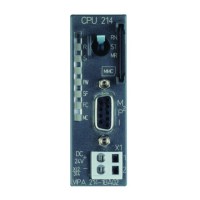Chapter 8 Deployment CPU 21xCAN Manual VIPA CPU 21x
8-2 HB103E - Rev. 05/45
Principles CAN-Bus
The CAN-Bus (Control Area Network) is an international standard for open
fieldbus systems intended for building, manufacturing and process
automation applications that was originally designed for automotive
applications.
Due to its extensive error detection facilities, the CAN-Bus system is
regarded as the most secure bus system. It has a residual error probability
of less than 4.7x10
-11
. Bad messages are flagged and retransmitted
automatically.
In contrast to Profibus and INTERBUS-S, CAN defines under the CAL-
level-7-protocol (CAL=CAN application layer) defines various level-7 user
profiles for the CAN-Bus. One standard user profile defined by the CIA
(CAN in Automation) e.V. is CANopen.
CANopen is a user profile for industrial real-time systems, which is
currently supported by a large number of manufacturers. CANopen was
published under the heading of DS-301 by the CAN in Automation
association (CIA). The communication specifications DS-301 define
standards for CAN devices. These specifications mean that the equipment
supplied by different manufacturers is interchangeable. The compatibility of
the equipment is further enhanced by the equipment specification DS-401
that defines standards for the technical data and process data of the
equipment. DS-401 contains the standards for digital and analog
input/output modules.
CANopen comprises a communication profile that defines the objects that
must be used for the transfer of certain data as well as the device profiles
that specify the type of data that must be transferred by means of other
objects.
The CANopen communication profile is based upon an object directory that
is similar to the profile used by Profibus. The communication profile DS-301
defines two standard objects as well as a number of special objects:
• Process data objects (PDO)
PDOs are used for real-time data transfers
• Service data objects (SDO)
SDOs provide access to the object directory for read and write
operations
General
CANopen

